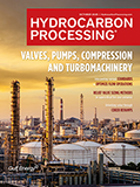Asia/Pacific
HP Industry Metrics
Cold weather, supply disruptions and geopolitical tensions continue to add more volatility to oil prices, supporting prices above $100/bbl. The events occurring in Ukraine, along with other political ..
HP People
Baldor has made two key promotions of late. Jeff Moore has been named vice president of the Baldor-Dodge brand mechanical product marketing group based in Greenville, South Carolina. His previous resp..
Achieve excellence and sustainability in your next turnaround
To consistently achieve pacesetter results on plant shutdowns and turnarounds, it is imperative that companies have a systematic turnaround management process (TMP).
Veolia to upgrade water treatment for Taiwan’s Formosa Petrochemical
As per Formosa's goal to expand the production capacity of its Mai Liao petrochemical complex and reduce its surface water consumption, Veolia will proceed to an upgrade of the site's water treatment plant.
Reliance plans maintenance at Jamnagar PX plant
Reliance Industries has taken a planned maintenance shutdown of one of its three paraxylene (PX) units at Jamnagar. The scheduled shutdown period is for a period of six weeks.
Gastech ’14: Asian gas buyers seek new pricing, more infrastructure
The use of new technology to develop gas supply—i.e., floating LNG and innovative GTL technologies—is contributing to the diversification of supplies.
CB&I wins Wheatstone LNG work in Australia
CB&I has been awarded a contract by Bechtel valued in excess of $625 million to provide structural, mechanical and piping construction work for all outside battery limits modules and associated units for the Chevron-operated Wheatstone Project at Ashburton North in Western Australia.
Foster Wheeler wins FEED work from S-OIL to upgrade Korea refinery
The upgrade of the S-OIL refinery includes the addition of a residue hydrodesulfurization unit, a residue fluid catalytic cracker and multiple downstream upgrading units to enable the refinery to produce more higher-value products and, in particular, maximize production of polymer-grade propylene.
India’s Reliance plans maintenance at Jamnagar refining complex
The maintenance is scheduled to begin on March 20 and last for about 3.5 weeks. Reliance says the work will enable it to carry out necessary modifications to improve the reliability and performance of the unit.
ExxonMobil to build butyl rubber, hydrocarbon resin plants in Singapore
Engineering and procurement activities have already begun, with construction of the plants expected to begin in the second half of 2014 and completion anticipated in 2017.

- thyssenkrupp Uhde selected by Dangote Fertilizer Ltd. to license four urea granulation units in Nigeria 11/21
- China's first coal-to-chemicals project with green hydrogen starts commercial operations 11/20
- Norsk e-Fuel and Braskem partner to turn captured carbon into long-lasting products 11/20
- Nigeria's Dangote refinery delays CDU maintenance to end of January 2026 11/20
- Technimont attends ground-breaking ceremony of Tengiz Gas separation Complex in Kazakhstan 11/20
- 42% of U.S. energy/critical infrastructure providers exposed to weaponized AI and email attacks 11/20




